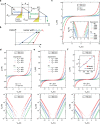Tunneling current modulation in atomically precise graphene nanoribbon heterojunctions
- PMID: 33953174
- PMCID: PMC8099867
- DOI: 10.1038/s41467-021-22774-0
Tunneling current modulation in atomically precise graphene nanoribbon heterojunctions
Abstract
Lateral heterojunctions of atomically precise graphene nanoribbons (GNRs) hold promise for applications in nanotechnology, yet their charge transport and most of the spectroscopic properties have not been investigated. Here, we synthesize a monolayer of multiple aligned heterojunctions consisting of quasi-metallic and wide-bandgap GNRs, and report characterization by scanning tunneling microscopy, angle-resolved photoemission, Raman spectroscopy, and charge transport. Comprehensive transport measurements as a function of bias and gate voltages, channel length, and temperature reveal that charge transport is dictated by tunneling through the potential barriers formed by wide-bandgap GNR segments. The current-voltage characteristics are in agreement with calculations of tunneling conductance through asymmetric barriers. We fabricate a GNR heterojunctions based sensor and demonstrate greatly improved sensitivity to adsorbates compared to graphene based sensors. This is achieved via modulation of the GNR heterojunction tunneling barriers by adsorbates.
Conflict of interest statement
The authors declare no competing interests.
Figures





References
-
- Esaki L, Tsu R. Superlattice and negative differential conductivity in semiconductors. IBM J. Res. Dev. 1970;14:61–65. doi: 10.1147/rd.141.0061. - DOI
-
- Kazarinov RE, Suris RA. Possibility of amplification of electromagnetic waves in a semiconductor superlattice. Fiz. Tekh. Polupr. 1971;5:798–800.

